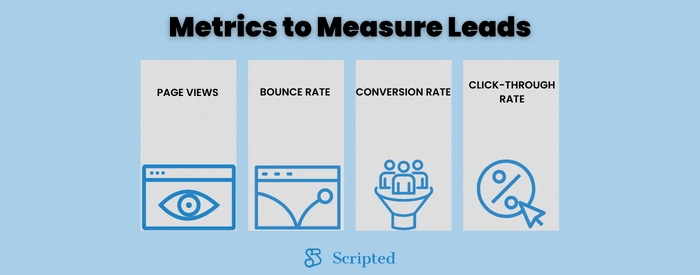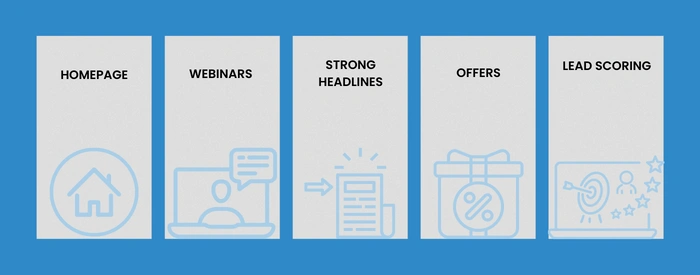- Blog Home
- Content Marketing
- Nicole Karlis
- Defining Lead Progress & How It Relates To Content Creation
Defining Lead Progress & How It Relates to Content Creation

Tracking lead progress is crucial when your goal is to measure and boost conversion rates.
While no magic content strategy will instantly lead to higher sales, there is a way to leverage data to see your content's impact on sales. The key is understanding what metrics to measure and what they mean concerning the bigger picture.
What Is Lead Progress?
A lead is any interaction with your brand involving an individual or organization that has the potential to become a future customer. This interest is known as lead generation, and the process is known as lead progress.
Think of lead progress as the lifecycle or timeline of various leads, starting with generation and ending in sales acceptance. This progress involves moving from unqualified to marketing qualified, ending with sales qualified. Since this process is rather complicated and often includes many moving parts, you must know what metrics to measure and when.
There are many examples of marketing qualified leads, which is why you should start focusing on some of these opportunities:
- Newsletter subscriptions
- Social media interactions
- Encouraging customers to contact your brand to discover more info (include contact info in your call-to-actions (CTAs))
- Offering downloadable content, such as ebooks and white papers
These examples are considered marketing-qualified leads because a potential customer voluntarily engaged with your brand. This differs from sales-qualified leads in that the latter involves people who have indicated they're ready to buy. Depending on how your enterprise is organized, these leads may be passed on to your sales team. However, whenever possible, creating a unified view of all leads across the entire marketing and sales funnel is essential for everyone involved.
This collaborative approach can strengthen marketing and sales teams, especially concerning leads. For example, when the sales team is encouraged to pass on valuable customer information, the marketing team can use that to create more engaging content.
What Metrics Should You Focus On?
As you know, there are dozens of metrics to keep track of, especially when investing in an omnichannel approach. Leads can present themselves across all channels as they bridge the gap between themselves and your brand. They might subscribe to your YouTube channel, follow you on Instagram, sign up for your newsletter, or visit your website. All of these steps can push them further into the lead-generation process.
So, which metrics can you depend on concerning lead progress?
The following are some examples of what you should keep an eye on.
- Page views — This metric measures how often a page is viewed on your website. Since this is an unqualified lead, it has not yet been nurtured enough within the sales cycle. Chances are, the majority of those visitors are interested in what you offer or need your services. However, this lead will not meet the criteria for moving it along within the sales pipeline.
- Bounce rate — This rate refers to the percentage of visitors leaving your website after viewing just one page. High bounce rates aren't ideal, as they may indicate poor targeting, poor design, slow loading speeds, or irrelevant landing pages. The average bounce rate is between 41% and 51%. However, your business's "normal" rate will depend on the industry and where your traffic comes from. Lower bounce rates support higher lead generation rates.
- Conversion rates — There are many conversion rates, including lead conversion rates. This metric showcases the percentage of visitors who come to your website and are captured as leads. If a conversion is a sale, then the lead is considered sales-qualified. Otherwise, it is marketing-qualified.
- Click-through rate — This metric can become a marketing-qualified lead if a click-through includes contact information. However, if this information is lacking, it will remain unqualified.
So, How Do Leads Relate to Content Creation?
Quality content is imperative for any marketing strategy to succeed, especially when your goal is to generate leads. For example, you may have a company blog. By regularly publishing authoritative, engaging content, you'll attract loyal readers. Visitors returning to your blog to access your published information means you have captured their interest. Once those readers sign-up for your newsletter, that is when you have successfully generated a lead.
Here are some ways to generate leads through content marketing:
- Social media
- Repurposed content
- Blogging
- Webinars
- Surveys
- Search engine optimization (SEO)
- Strategic website updates, such as adding customer testimonials and revising product descriptions
The Link Between Content Creation and Lead Generation
Here are just some of the ways content relates to lead generation and progress:
- When you regularly publish quality content, it will attract qualified traffic. As you're aware, traffic is the most vital metric for the success of your site. However, qualified traffic is different. This metric refers to visitors that are more likely to become customers. Content marketing can attract high-value visitors who are already interested in what you offer. Converting them into paying customers becomes much easier once they discover your content.
- Your ability to demonstrate your brand as an industry expert. Since 53.3% of all website traffic comes from organic search, nearly 93% of which comes from Google, when people end up on your site, it's because of searched keywords. Investing in quality content shows these potential customers you care enough to help them with their problems while providing content that interests them. When it comes time to buy what you offer, you'll be on their radar based on the content you previously published.
- Showcase the services you offer to drive higher conversions. The goal of most content is to provide information or entertainment without being too pushy or salesy. However, content marketing is an excellent way to provide informative how-to guides and listicles that help the reader, ending with a clear CTA. For example, if you're a mechanic, you could create a basic article on changing your spare time. At the end of the post or article, you can remind the reader that spare tires aren't meant to be a permanent solution. Include your contact page, encouraging the reader to take action, resulting in new leads.
Lead Progress Tips and Tricks
Ready to supercharge lead generation this year and beyond? Here are some suggestions to help you guide you:
- Start with your homepage — Most marketers will notice that the homepage receives the most views. By adding a simple homepage CTA, you could significantly boost lead generation.
- Link to webinars in your content — Webinars are gaining popularity because they are relatively low-cost and highly effective. This medium allows you to get in front of a targeted audience that chose to register to access your content. Creating a valuable webinar can make it easy to generate qualified leads. So, when creating blog posts or social media content, include inline links to "register" for your upcoming webinar.
- Create powerful headlines to attract readers — You want potential customers to click through to your content, which is why strong headlines are crucial. Consider the structure, relevant keywords, length, and inclusion of a verb. Data shows that eight out of ten people will click your headline if it catches their attention. However, that's just the beginning. The content must be valuable to encourage those visitors to keep reading and becoming a lead.
- Create an offer they can resist — If you have been struggling to generate leads, your offer may not be enticing enough. When provided with the option to join your mailing list, register for your webinar, or download your latest ebook, you want the visitor to say yes immediately. The goal here is to create content that is exclusive and relevant. When you achieve that, it becomes desirable.
- Experiment with lead scoring — This scoring method allows you to rank prospects on a scale based on perceived value. Most marketing automation platforms now offer a lead-scoring option, assigning values to certain behaviors, conversions, or social media interactions.
The most vital step to take is to track your leads. There are several ways to do so, including spreadsheets, automated databases, or CRMs. Dive deeper into some of the best ways to track sales, including lead-tracking tools and customized lead-generation forms.
Scripted Can Help
The relationship between quality content and your ability to generate leads is clear. The more valuable content you publish, the quicker and more seamless lead progress will become. After all, your content helps bridge the communication gap between you and prospective customers.
If you need content that ticks every box concerning quality, originality, and the ability to convert, Scripted offers a pool of talented, industry-specific writers. Scripted's all-in-one platform makes this process simple, whether you need ebooks, social media content, newsletters, press releases, blog posts, or other content.
Outsourcing this task to professional freelance writers will allow you to focus on the bigger picture of lead progress. As you gain insight, you can pivot your strategies to ensure higher conversions and a supercharged ROI.
Ready to take your content strategy to the next level? Start your 30-day free trial today!




